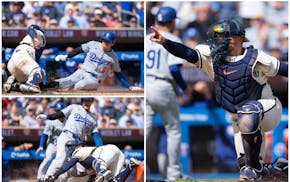FORT MYERS, FLA. - Jason Marquis is beginning his 17th season of professional baseball, 13 of those in the major leagues.
He's pitched in 326 games for six teams. That comes to 1,675 2/3 innings and 26,695 pitches thrown, according to baseball-reference.com. And that doesn't even count his workload in the minors, postseason or spring training.
In other words, he has a lot of miles on his right arm.
Marquis has suffered only one significant injury to his pitching arm, however. He had surgery to remove bone chips from his elbow in 2010. Signed by the Twins this offseason, the former All-Star will fill a spot at the end of the rotation and, based on his history, likely provide some durability.
I asked Marquis to explain how he gets his arm ready for a season. Just his normal routine in a typical offseason, from the moment he walks out of the clubhouse after the season until Opening Day. He gave a detailed, 35-minute outline of a regimented training program that he's tweaked and refined over the years. He treats the process systematically and swears by it. He considers every part an important step in getting him ready to pitch another season.
That doesn't always guarantee success or mean he'll avoid arm problems once the season starts. But he believes his longevity is the result of his preparation over the winter.
"I enjoy this part of the game," he said.
Once the season ends, Marquis returns to his home in New York and takes a five-week break. He does some light running and elliptical work and plays pickup basketball occasionally. He also throws a football a handful of times, just to keep his shoulder socket and elbow "oiled."
In Week 6, he resumes a workout routine that consists of weightlifting and core work four times a week and running three times a week. He also begins a rehabilitation process with his personal physical therapist, which he considers a vital component of his program.
Essentially, Marquis begins each offseason as if he suffered an arm injury and needs rehab. He does this even if he's perfectly healthy. He calls it "prehab." He does 25-30 sessions of prehab work on his shoulder and elbow.
"How many guys come back from surgery and say, 'Oh man, this is the strongest I've felt,'?" he said. "That's because they probably put work in that they never put in when they're healthy. I have the mindset that I had an injury and I'm going to rehab it like I had an injury to rebuild strength so I come into the season strong and fresh."
Marquis doesn't pick up a baseball until Jan. 7. He used to begin throwing in December as a younger pitcher, but he altered his routine after dealing with arm trouble in 2002. The pain became so severe he needed a cortisone shot just to lift weights. He didn't resume throwing until Feb. 2, only a few weeks before he reported to camp. Despite the late start, he still got his arm in shape by the start of the season.
"I said, let's split the difference," he said. "That's how I came up with January."
Once he starts throwing, Marquis completes a five-week program before he even steps on a mound. He throws five days a week, starting from a distance of 45 feet. He moves back to 60 feet the second week, then 75 feet, 90 and finally 120.
He makes 40 throws at each distance the first three days. He doubles that amount the final two days, except for the longest distance. He has only one session of long toss each day.
Marquis is ready to pitch off a mound for the first time at that point. He has four sessions -- 35 to 50 pitches each time -- before leaving for spring training. He throws only fastballs the first two sessions. Then he adds a changeup. He mixes in a slider in his final session.
"I always tell myself that I'm going to take it nice and easy," he said, "but I get so amped up and excited to be on the mound that I overdo it the first one every year. Without fail."
He joins his team's program once he arrives at spring training. The routine includes games, bullpen sessions and live batting practices, always followed by ice treatment for recovery.
Marquis considers himself a "thrower" so he wants as much work as possible. Once, he had a pitching coach in the minors step in front of him, grab the catcher's return throw with his bare hand and refuse to move off the mound until Marquis agreed to stop his bullpen session.
"I'm always a guy who tinkers," he said. "I do a lot of things based on feel. Some days your body doesn't feel right, even though you're doing what you think you're supposed to do. I want to feel it."
Rather than obsess over his pitch count in spring games or bullpen sessions, Marquis focuses more on the "up and down" routine. Pitch an inning, sit in the dugout, start another inning, and so on. Getting adjusted to that stress on the arm, he said, is more important than the number of pitches he throws.
Marquis believes he could push his arm to pitch five or six innings right now, but that's not necessary. He still has several more weeks of spring training to build his stamina so that his arm is ready for a new season.
"You have to learn your body," he said. "It's about having a plan and attacking that plan."
Chip Scoggins • ascoggins@startribune.com

Scoggins: Finch feeling heat of the Suns as playoff battle looms
Scoggins: Why 'championship or bust' fits these Wolves

Scoggins: Anatomy of a game-saving play as Correa throws out Ohtani


